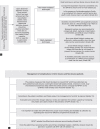Open Abdomen in a Critically Ill Patient
- PMID: 33354041
- PMCID: PMC7724942
- DOI: 10.5005/jp-journals-10071-23613
Open Abdomen in a Critically Ill Patient
Abstract
One of the damage control strategies used to avoid or treat abdominal compartment syndrome is "open abdomen (OA)," where the facial edges and the skin is left open, exposing the abdominal viscera. Although it reduces the mortality both in trauma and non-trauma abdominal complications, it does create a significant challenge in an intensive care setting, as it has physiological consequences that need early recognition and prompt treatment both in the intensive care unit and in the operating room. The article aims to review literature on "open abdomen," describe the challenges in such cases, and proposes a guideline for the intensivist in managing a patient with an OA. How to cite this article: Mitra LG, Saluja V, Dhingra U. Open Abdomen in a Critically Ill Patient. Indian J Crit Care Med 2020;24(Suppl 4):S193-S200.
Keywords: Abdominal compartment syndrome; Enteroatmospheric fistula; Negative pressure wound therapy; Open abdomen; Peritoneal sepsis; Primary or temporary abdominal closure.
Copyright © 2020; Jaypee Brothers Medical Publishers (P) Ltd.
Conflict of interest statement
Source of support: Nil Conflict of interest: None
Figures



References
Publication types
LinkOut - more resources
Full Text Sources
